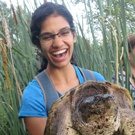Ontario Nature Blog
Receive email alerts about breaking conservation
and environmental news.
© Lora Denis
Research at Sydenham River Nature Reserve © David Coulson
You can help safeguard habitat for crawlers, fliers, climbers and future generations by donating or selling land to be part of Ontario Nature’s Nature Reserves system. Land protection from development and degradation is key to maintaining habitat integrity, ecological corridors, enhancing climate resiliency, and creating opportunities for people to connect with nature.
Our Nature Reserves are comprised of 26 properties totaling 3,183 ha. Spanning from the Ottawa River valley to the east, Pelee Island to the south and St. Joseph Island to the north, these properties comprise rare and diverse habitats critical for the survival and reproduction of many birds, bats, snakes, invertebrates and more.

Many of these properties were gifts from people who deeply care for nature, wanting to leave a legacy for future generations. Read more about their stories here.
“It’s important that we protect what’s left-for our children and great-grandchildren, and for the wildlife we hope they’ll get to enjoy too.”
– Ada & Joel Farber, land donors

Ontario Nature conducts science-based assessments to evaluate eligibility and alignment with our strategic priorities to be added to our nature reserves system. We are accepting gifts in:

Ontario Nature was the first land trust in the province, protecting habitat for rare species and places for people to grow their connection to nature since the 1960s. All properties meet rigorous criteria to qualify as nature reserves for inclusion in the Canadian Protected and Conserved Areas Database, contributing towards the national target to protect 30 percent of all lands and waters by 2030. As an active member of the Ontario Land Trust Alliance and collaborative partner with many conservation organizations, we are well positioned to care for your lands in perpetuity.
Once land is added to our nature reserves system, it will be cared for and protected forever. Stewardship is tailored based on identified biodiversity values and mitigating threats. Activities may include biodiversity inventories, habitat restoration, collaborating with Indigenous communities (if interest aligns and capacity exists), and more!
Transferring land is a personal and important decision. Rest assured, there are a variety of mechanisms including donation, sale, split receipt, and conservation easement agreements. Previous donors have benefited from tax incentives provided through Canada’s Ecological Gifts Program.
Learn more about how you can contribute to our Nature Reserves program by contacting Smera Sukumar directly at 1-800-440-2366 ext. 229 or by email at smeras@ontarionature.org.

Lakeside daisy, Saugeen Alvar Nature Reserve © Noah Cole
Just imagine if the areas highlighted in green on the article’s map were entirely protected. No farms, no towns, no highways. Just forests, fields and wetlands. Given hundreds of years, who knows what new species might evolve there? But for now, in our lifetimes, whatever lands can be preserved in these areas are badly needed refuges for the wild plants and animals that already exist and are just trying to survive.
In my view, people who gift (or sell) to conservation organizations the natural lands that they have had the privilege of owning are among the greatest heroes on our planet.